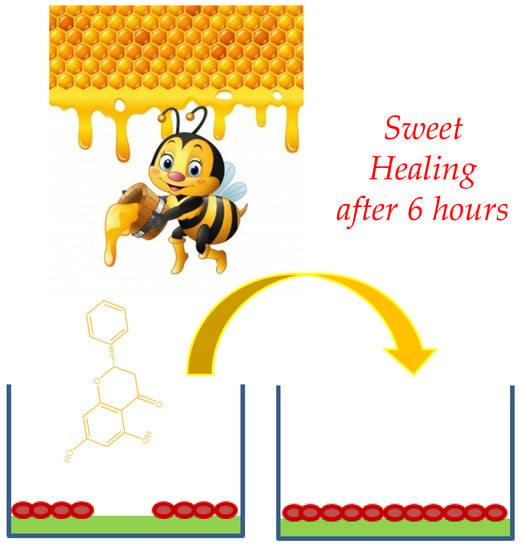Evaluation of the In Vitro Wound-Healing Activity of Calabrian Honeys
Abstract
1. Introduction
2. Materials and Methods
2.1. Chemical Reagents
2.2. Honey Types
2.3. Extraction Procedure using Amberlite® XAD-4
2.4. Liquid–Liquid Extraction
2.5. Gas Chromatography/Mass Spectrometry (GC/MS) Analyses
2.6. 1H-Nuclear Magnetic Resonance Analysis (NMR)
2.7. Isolation of Pinocembrin
2.8. Cell Culture and Treatments
2.9. Scratch Wound-Healing Assay
2.10. Cell Proliferation Assay
2.11. Cell Viability Assay
2.12. Statistical Analysis
3. Results
3.1. Extraction
3.2. Analysis of Compounds
3.3. Pinocembrin Data Analysis
3.4. Scratch Wound-Healing Assay
3.5. Cell Proliferation Assay
4. Discussion
5. Conclusions
Author Contributions
Funding
Acknowledgments
Conflicts of Interest
References
- Sivamani, R.K. Eicosanoids and Keratinocytes in Wound Healing. Adv. Wound Care 2014, 3, 476–481. [Google Scholar] [CrossRef] [PubMed]
- Kwon, S.H.; Padmanabhan, J.; Gurtner, G.C. Mechanobiology of skin diseases and wound healing. In Mechanobiology in Health and Disease; Verbruggen, S.W., Ed.; Academic Press: Cambridge, MA, USA, 2018; Chapter 14; pp. 415–448. ISBN 978-0-12-812952-4. [Google Scholar]
- Gabriele, S.; Buchanan, B.; Kundu, A.; Dwyer, H.C.; Gabriele, J.P.; Mayer, P.; Baranowski, D.C. Stability, Activity, and Application of Topical Doxycycline Formulations in a Diabetic Wound Case Study. Wounds 2019, 31(2), 49–54. [Google Scholar] [PubMed]
- Eteraf-Oskouei, T.; Najafi, M. Traditional and Modern Uses of Natural Honey in Human Diseases: A Review. Iran. J. Basic Med. Sci. 2013, 16, 731–742. [Google Scholar] [PubMed]
- Rana, S.; Mishra, M.; Yadav, D.; Subramani, S.K.; Katare, C.; Prasad, G.B.K.S. Medical uses of honey: A review on its benefits to human health. Prog. Nutr. 2018, 20 (Suppl. 1), 5–14. [Google Scholar]
- Badolato, M.; Carullo, G.; Cione, E.; Aiello, F.; Caroleo, M.C. From the hive: Honey, a novel weapon against cancer. Eur. J. Med. Chem. 2017, 142, 290–299. [Google Scholar] [CrossRef] [PubMed]
- Eroglu, O.; Deniz, T.; Kisa, U.; Comu, F.M.; Kaygusuz, S.; Murat Kocak, O. The effect of different types of honey on healing infected wounds. J. Wound Care 2018, 27, S18–S25. [Google Scholar] [CrossRef] [PubMed]
- Mirzaei, B.; Etemadian, S.; Reza Goli, H.; Bahonar, S.; Gholami, S.A.; Karami, P.; Farhadi, M.; Tavakoli, R. Construction and analysis of alginate-based honey hydrogel as an ointment to heal of rat burn wound related infections. Int. J. Burns Trauma 2018, 8, 88–97. [Google Scholar]
- Martinotti, S.; Bucekova, M.; Majtan, J.; Ranzato, E. Honey: An Effective Regenetative Medicine Product in Wound Management. Curr. Med. Chem. 2018. [CrossRef]
- Burlando, B.; Cornara, L. Honey in derrmatology and skin care: A review. J. Cosmet. Dermatol. 2013, 12, 306–313. [Google Scholar] [CrossRef]
- Lindberg, T.; Anderson, O.; Palm, M.; Fagerström, C. A systematic review and meta-analysis of dressings used for wound healing: The efficiency of honey compared to silver on burns. Contemp. Nurse 2015, 51, 121–134. [Google Scholar] [CrossRef]
- Oliveira, A.; Sousa, J.C.; Silva, A.C.; Melo, L.D.R.; Sillankorva, S. Chestnut Honey and Bacteriophage Application to Control Pseudomonas aeruginosa and Escherichia coli Biofilms: Evaluation in an ex vivo Wound Model. Front. Microbiol. 2018, 9, 1725. [Google Scholar] [CrossRef] [PubMed]
- Aurongzeb, M.; Kamran Azim, M. Antimicrobial properties of natural honey: A review of literature. Pak. J. Biochem. Mol. Biol. 2011, 44, 118–124. [Google Scholar]
- Weiß, K.T.; Fante, M.; Köhl, G.; Schreml, J.; Haubner, F.; Kreutz, M.; Haverkampf, S.; Berneburg, M.; Schreml, S. Proton-sensing G protein-coupled receptors as regulators of cell proliferation and migration during tumor growth and wound healing. Exp. Dermatol. 2017, 26, 127–132. [Google Scholar] [CrossRef]
- Saikaly, S.K.; Khachemoune, A. Honey and Wound Healing: An Update. Am. J. Clin. Dermatol. 2017, 18, 237–251. [Google Scholar] [CrossRef] [PubMed]
- Martinotti, S.; Ranzato, E. Honey, Wound Repair and Regenerative Medicine. J. Funct. Biomater. 2018, 9, 34. [Google Scholar] [CrossRef] [PubMed]
- Ranzato, E.; Martinotti, S.; Burlando, B. Epithelial mesenchymal transition traits in honey-driven keratinocyte wound healing: Comparison among different honeys. Wound Repair Regen. 2012, 20, 778–785. [Google Scholar] [CrossRef] [PubMed]
- Chaudhary, A.; Bag, S.; Banerjee, P.; Chatterjee, J. Honey Extracted Polyphenolics Reduces Experimental Hypoxia in Human Keartinocytes Culture. J. Agric. Food Chem. 2017, 65, 3460–3473. [Google Scholar] [CrossRef] [PubMed]
- Majtan, J. Honey: An immunomodulator in wound healing. Wound Repair Regen. 2014, 22, 187–192. [Google Scholar] [CrossRef] [PubMed]
- Ahmed Mesaik, M.; Dastagir, N.; Uddin, N.; Rehman, K.; Kamran Azim, M. Characterization of Immuno-modulatory Activities of Honey Glycoproteins and Glycopeptides. J. Agric. Food Chem. 2015, 63, 177–184. [Google Scholar] [CrossRef]
- Dong, Y.; Huang, H.; Zhao, N.; Sun-waterhouse, D.; Lin, L.; Xiao, C. Mechanisms underlying the xanthine oxidase inhibitory effects of dietary flavonoids galangin and pinobanksin. J. Funct. Foods 2016, 24, 26–36. [Google Scholar] [CrossRef]
- Aiello, F.; Armentano, B.; Polerà, N.; Carullo, G.; Loizzo, M.R.; Bonesi, M.; Cappello, M.S.; Capobianco, L.; Tundis, R. From Vegetable Waste to New Agents for Potential Health Applications: Antioxidant Properties and Effects of Extracts, Fractions and Pinocembrin from Glycyrrhiza glabra L. Aerial Parts on Viability of Five Human Cancer Cell Lines. J. Agric. Food Chem. 2017, 65, 7944−7954. [Google Scholar] [CrossRef] [PubMed]
- Tundis, R.; Frattaruolo, L.; Carullo, G.; Armentano, B.; Badolato, M.; Loizzo, M.R.; Aiello, F.; Cappello, A.R. An ancient remedial repurposing: Synthesis of new pinocembrin fatty acid acyl derivatives as potential antimicrobial/anti-inflammatory agents. Nat. Prod. Res. 2018. [CrossRef] [PubMed]
- Di Rosa, A.R.; Marino, A.M.F.; Leone, F.; Corpina, G.G.; Giunta, R.P.; Chiofalo, V. Characterization of Sicilian Honeys Pollen Profiles Using a Commercial E-Tongue and Melissopalynological Analysis for Rapid Screening: A Pilot Study. Sensors 2018, 18, 4065. [Google Scholar] [CrossRef]
- Istasse, T.; Jacquet, N.; Berchem, T.; Haubrige, E.; Nguyen, B.K.; Richel, A. Extraction of Honey Polyphenols: Method Development and Evidence of Cis Isomerization. Anal. Chem. Insights 2016, 11, 49–57. [Google Scholar] [CrossRef] [PubMed]
- Chen, Y. Scratch Wound Healing Assay. Bio-Protocol 2012, 2, e100. [Google Scholar] [CrossRef]
- Chiocchio, I.; Poli, F.; Governa, P.; Biagi, M.; Lianza, M. Wound healing and in vitro antiradical activity of five Sedum species grown within two sites of community importance in Emilia Romagna (Italy). Plant Biosyst. 2018. [Google Scholar] [CrossRef]
- Vichai, V.; Kirtikara, K. Sulforhodamine B colorimetric assay for cytotoxicity screening. Nat. Protoc. 2006, 1, 1112–1116. [Google Scholar] [CrossRef] [PubMed]
- Guichard, A.; Humbert, P.; Tissot, M.; Muret, P.; Courderot-Masuyer, C.; Viennet, C. Effects of topical corticosteroids on cell proliferation, cell cycle progression and apoptosis: In vitro comparison on HaCaT. Int. J. Pharm. 2015, 479, 422–429. [Google Scholar] [CrossRef]
- Governa, P.; Biagi, M. Copaifera langsdorffii Desf.: In Vitro investigation on anti-Helicobacter pylori and anti-inflammatory activities of oleoresin and fruit methanolic extract. Plant Biosyst. 2019. accepted. [Google Scholar] [CrossRef]
- Del Campo, G.; Zuriarrain, J.; Zuriarrain, A.; Berregi, I. Quantitative determination of carboxylic acids, amino acids, carbohydrates, ethanol and hydroxymethylfurfural in honey by 1H NMR. Food Chem. 2016, 196, 1031–1039. [Google Scholar] [CrossRef]
- Schievano, E.; Stocchero, M.; Morelato, E.; Facchin, C.; Mammi, S. An NMR-based metabolomic approach to identify the botanical origin of honey. Metabolomics 2012, 8, 679–690. [Google Scholar] [CrossRef]
- Schievano, E.; Tonoli, M.; Rastrelli, F. NMR Quantification of Carbohydrates in Complex Mixtures. A Challenge on Honey. Anal. Chem. 2017, 89, 13405–13414. [Google Scholar] [CrossRef] [PubMed]
- D’Agostino, A.; Stellavato, A.; Busico, T.; Papa, A.; Tirino, V.; Papaccio, G.; La Gatta, A.; de Rosa, M.; Schiraldi, C. In vitro analysis of the effects on wound healing of high- and low-molecular weight chains of hyaluronan and their hybrid H-HA/L-HA complexes. BMC Cell Biol. 2015, 16, 19. [Google Scholar] [CrossRef] [PubMed]
- Wedler, J.; Daubitz, T.; Schlotterbeck, G.; Butterweck, V. In vitro anti-inflammatory and wound-healing potential of a Phyllostachys edulis leaf extract–identification of isoorientin as an active compound. Planta Med. 2014, 80, 1678–1684. [Google Scholar] [CrossRef] [PubMed]
- Ho, T.J.; Jiang, S.J.; Lin, G.H.; Li, T.S.; Yiin, L.M.; Yang, J.S.; Hsieh, M.C.; Wu, C.C.; Lin, J.G.; Chen, H.P. The in Vitro and in Vivo Wound Healing Properties of the Chinese Herbal Medicine “jinchuang Ointment”. Evid.-Based Complement. Altern. Med. 2016, 2016, 1654056. [Google Scholar] [CrossRef] [PubMed]
- Karna, S. In-vitro Wound Healing Effect of 15-Hydroxyprostaglandin Dehydrogenase Inhibitor from Plant. Pharmacogn. Mag. 2017, 13, S122–S126. [Google Scholar] [CrossRef] [PubMed]
- Carretero, M.; Escamez, M.J.; Garcia, M.; Duarte, B.; Holguin, A.; Retamosa, L.; Jorcano, J.L.; Del Rio, M.; Larcher, F. In vitro and in vivo wound healing-promoting activities of human cathelicidin LL-37. J. Investig. Dermatol. 2008, 128, 223–236. [Google Scholar] [CrossRef]
- Jangpromma, N.; Preecharram, S.; Srilert, T.; Maijaroen, S.; Mahakunakorn, P.; Nualkaew, N.; Daduang, S.; Klaynongsruang, S. In Vitro and in Vivo Wound Healing Properties of Plasma and Serum from Crocodylus siamensis Blood. J. Microbiol. Biotechnol. 2016, 26, 1140–1147. [Google Scholar] [CrossRef]
- El Gazaerly, H.; Elbardisey, D.M.; Eltokhy, H.M.; Teaama, D. Effect of Transforming Growth Factor Beta 1 on Wound Healing in Induced Diabetic Rats. Int. J. Health Sci. 2013, 7, 160–172. [Google Scholar] [CrossRef]
- Oryan, A.; Alemzadeh, E.; Moshiri, A. Biological properties and therapeutic activities of honey in wound healing: A narrative review and meta-analysis. J. Tissue Viability 2016, 25, 98–118. [Google Scholar] [CrossRef]
- Martinotti, S.; Ranzato, E. Propolis: A new frontier for wound healing? Burns Trauma 2015, 3, 9. [Google Scholar] [CrossRef] [PubMed]
- Soromou, L.W.; Chu, X.; Jiang, L.; Wei, M.; Huo, M.; Chen, N.; Guan, S.; Yang, X.; Chen, C.; Feng, H.; et al. In vitro and in vivo protection provided by pinocembrin against lipopolysaccharide-induced inflammatory responses. Int. Immunopharmacol. 2012, 14, 66–74. [Google Scholar] [CrossRef] [PubMed]
- Lan, X.; Wang, W.; Li, Q.; Wang, J. The Natural Flavonoid Pinocembrin: Molecular Targets and Potential Therapeutic Applications. Mol. Neurobiol. 2016, 53, 1794–1801. [Google Scholar] [CrossRef]
- Rasul, A.; Millimouno, F.M.; Ali Eltayb, W.; Ali, M.; Li, J.; Li, X. Pinocembrin: A novel natural compound with versatile pharmacological and biological activities. BioMed Res. Int. 2013, 2013, 379850. [Google Scholar] [CrossRef] [PubMed]
- Brem, H.; Tomic-Canic, M. Cellular and molecular basis of wound healing in diabetes. J. Clin. Investig. 2007, 117, 1219–1222. [Google Scholar] [CrossRef] [PubMed]
- Tsioutsiou, E.E.; Giachetti, D.; Miraldi, E.; Governa, P.; Magnano, A.R.; Biagi, M. Phytotherapy and skin wound healing. Acta Vulnol. 2016, 14, 126–139. [Google Scholar]

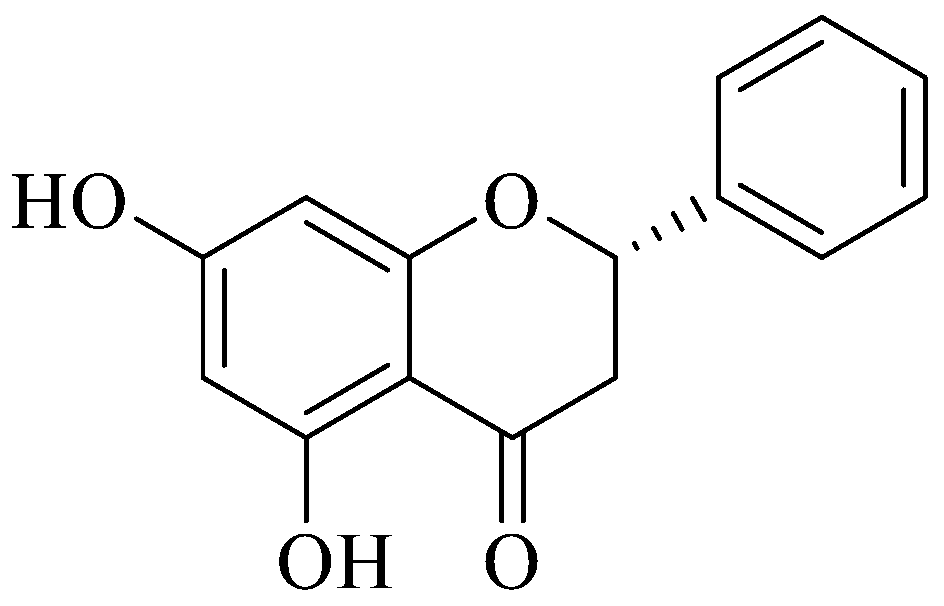
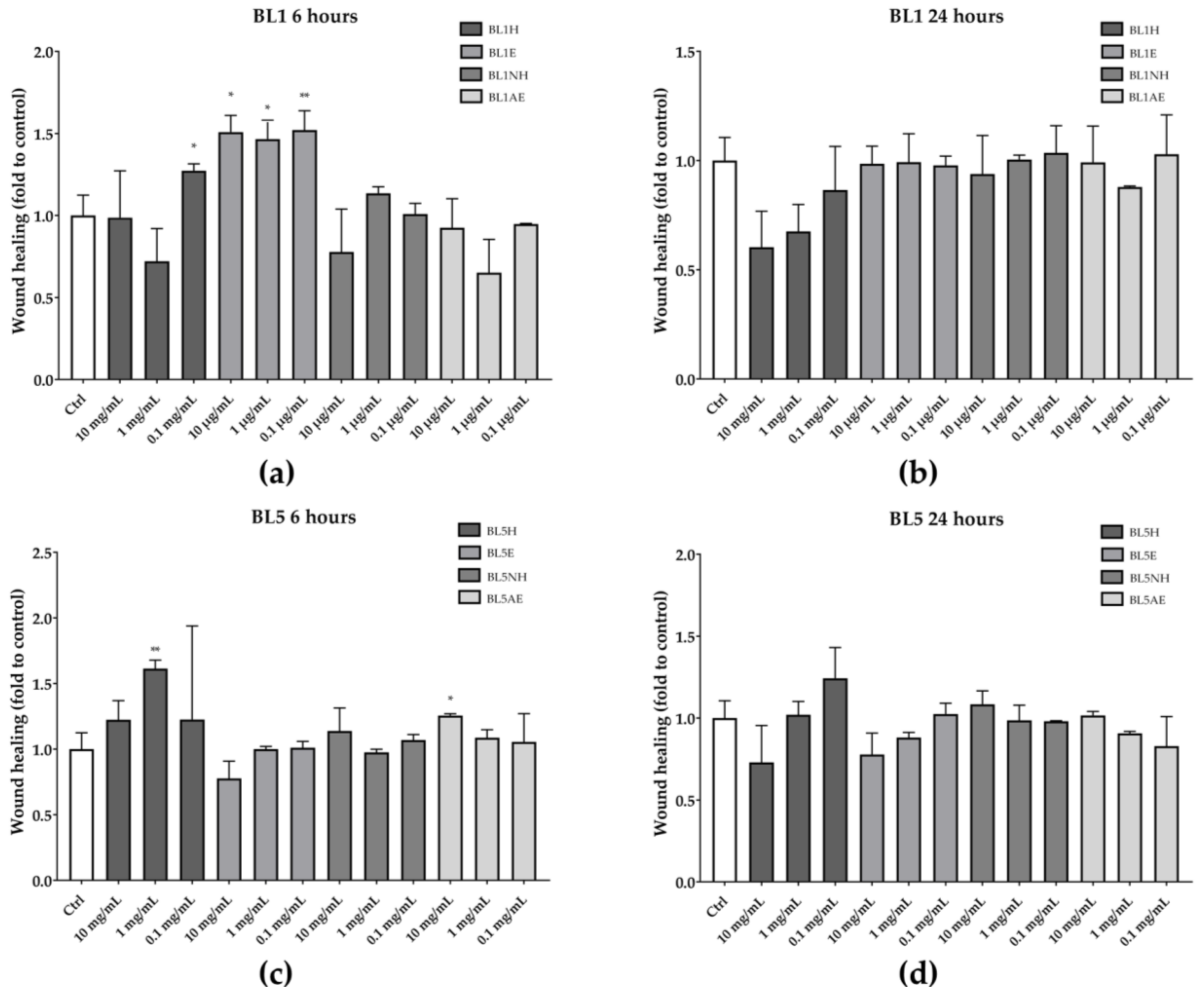
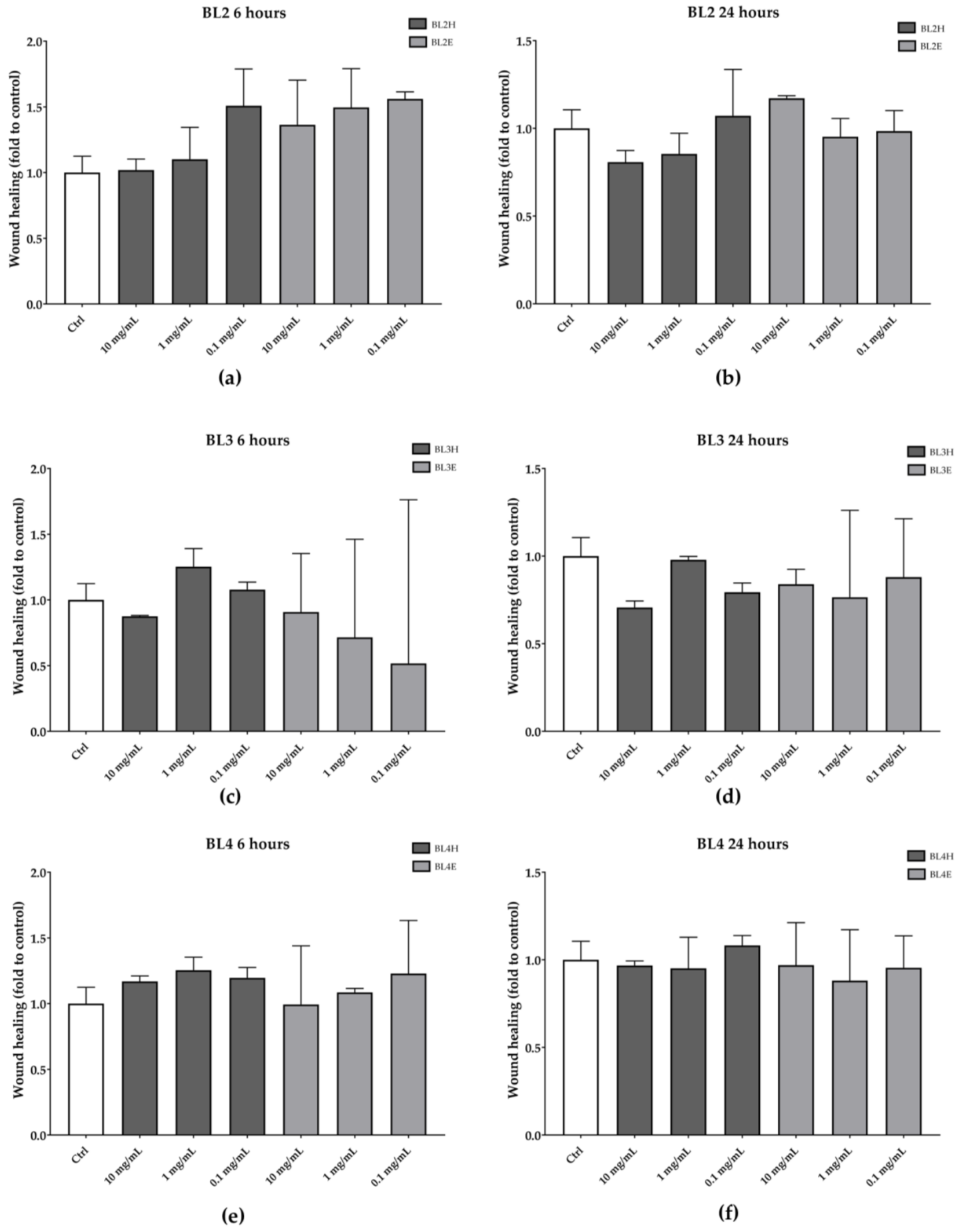
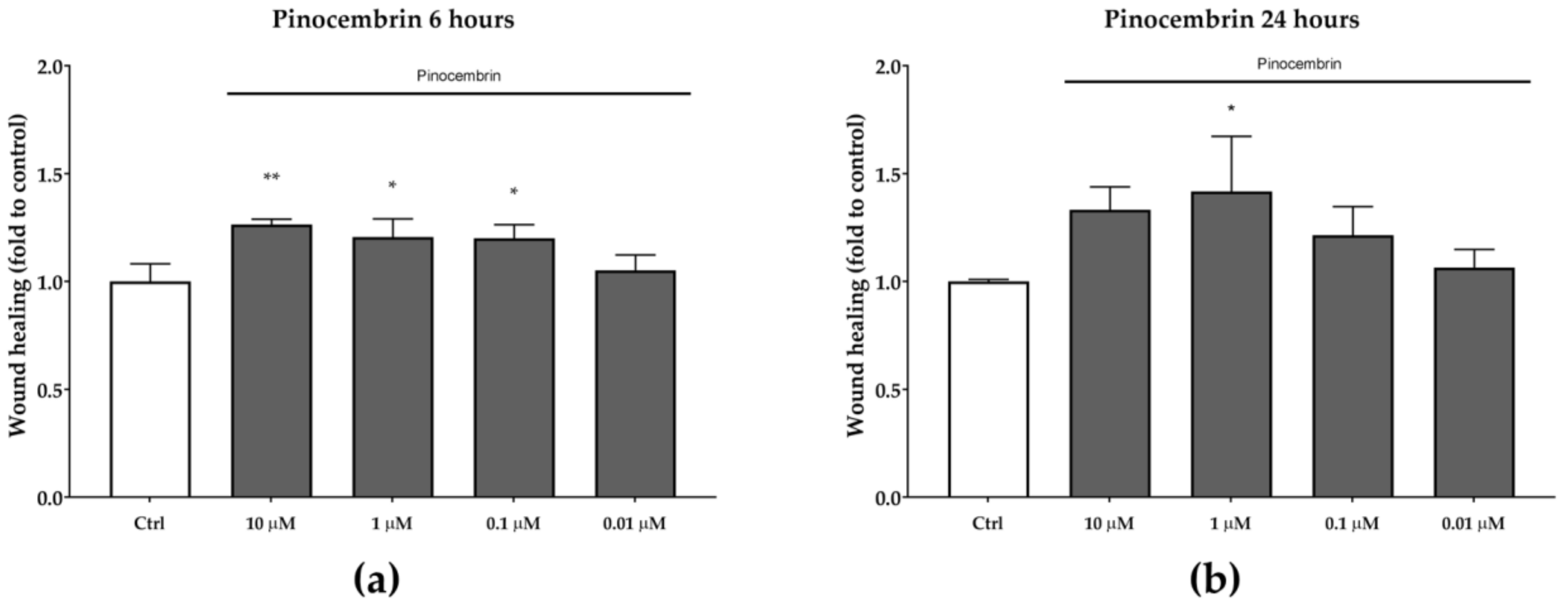
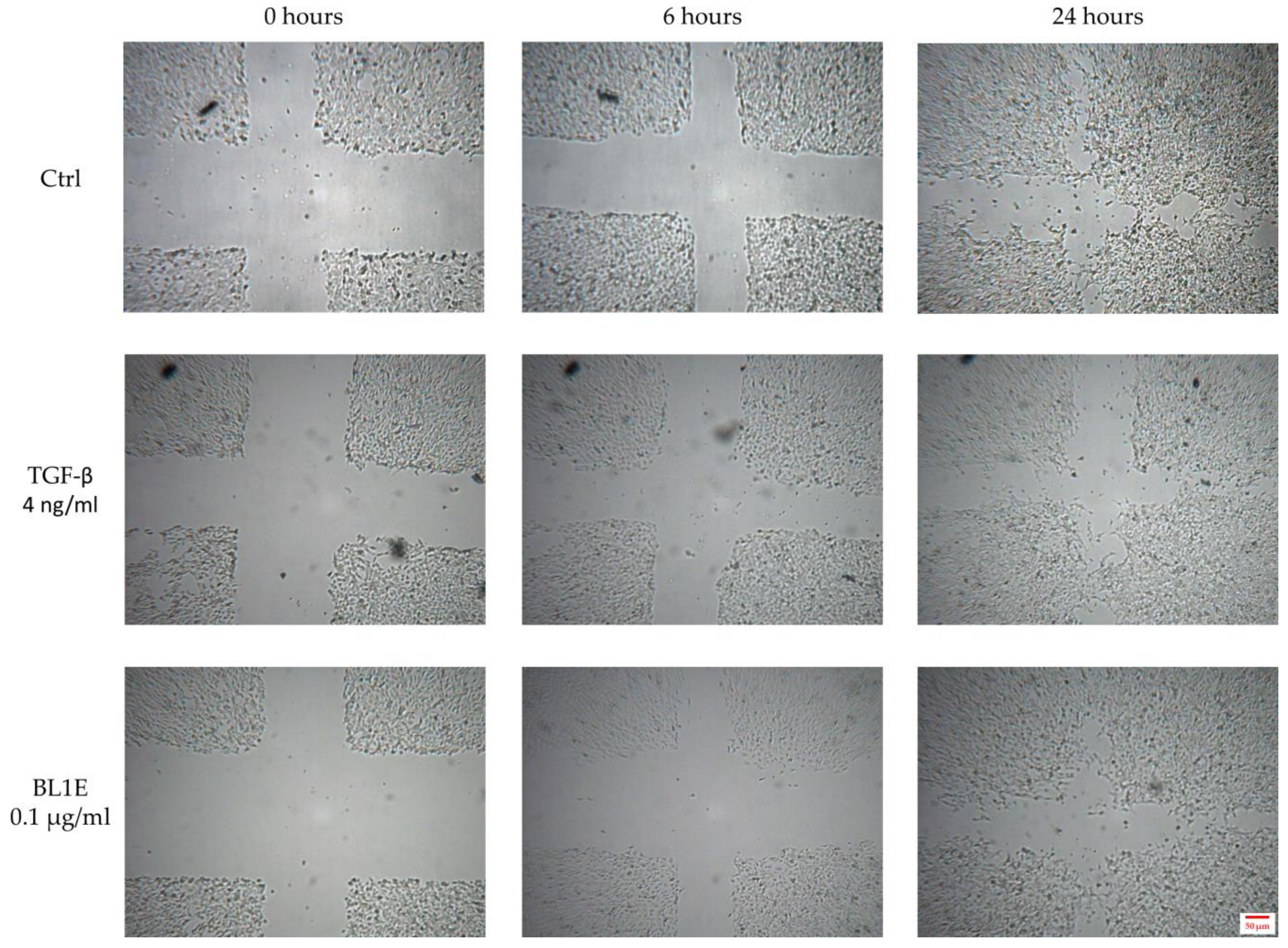
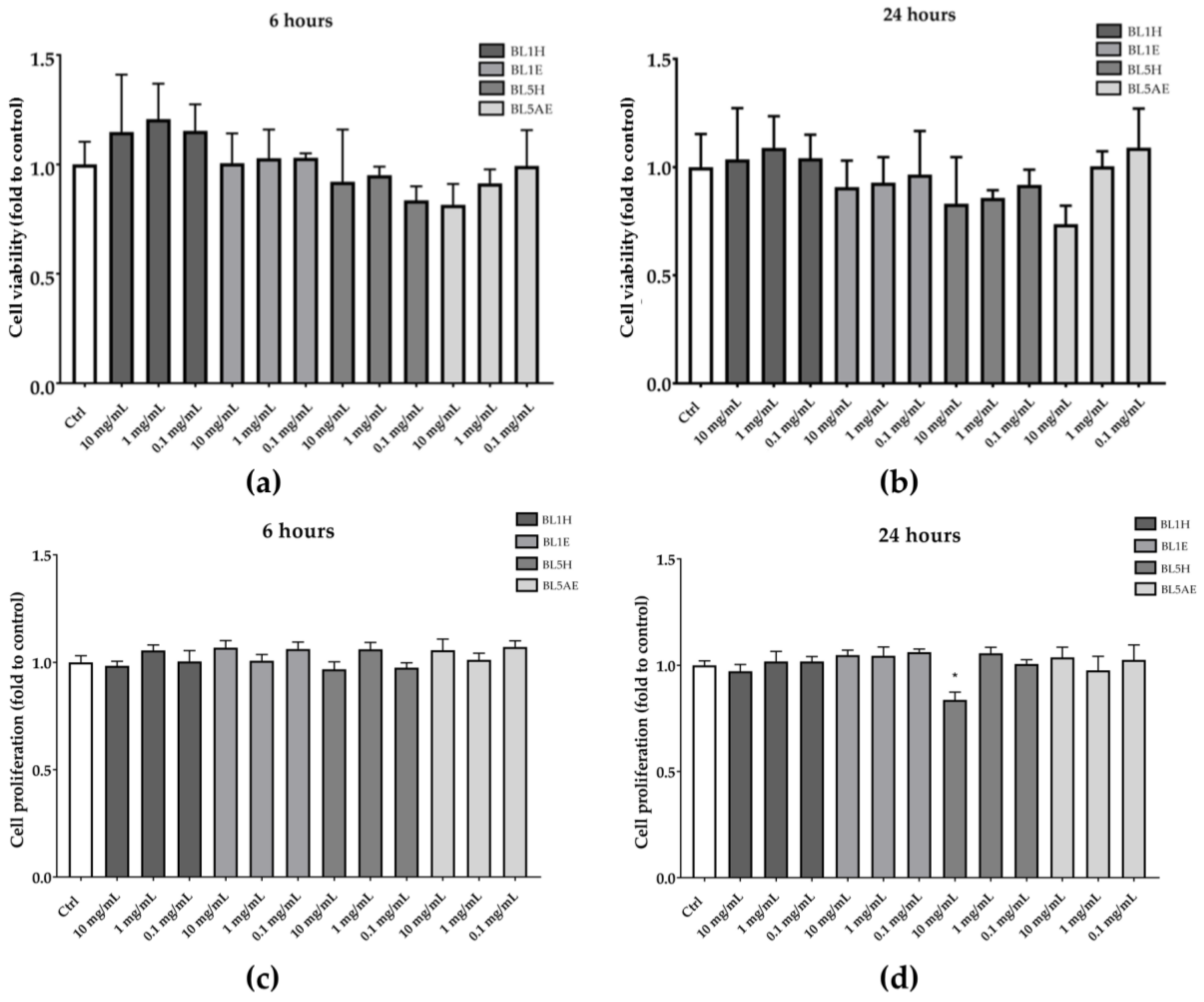
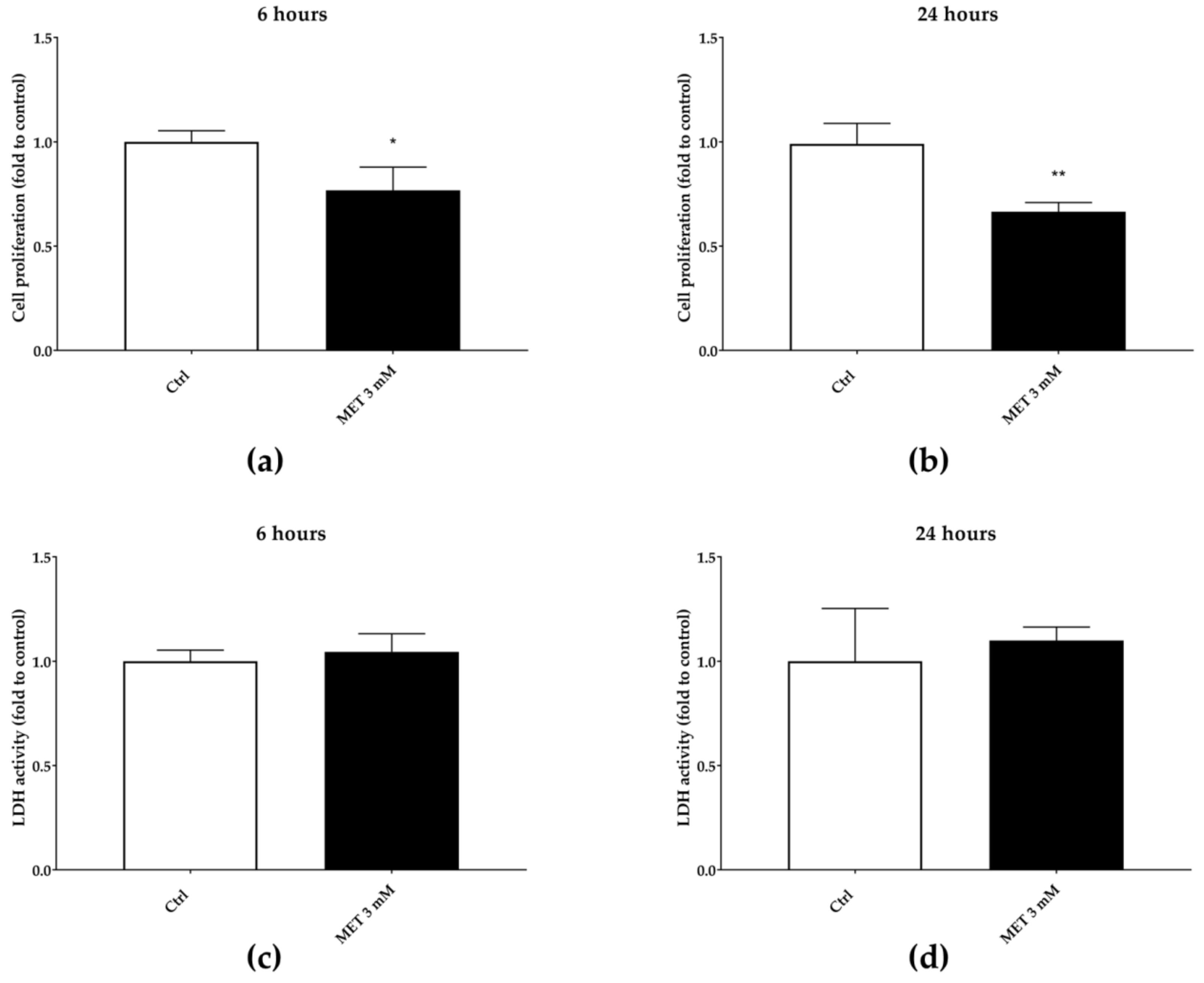
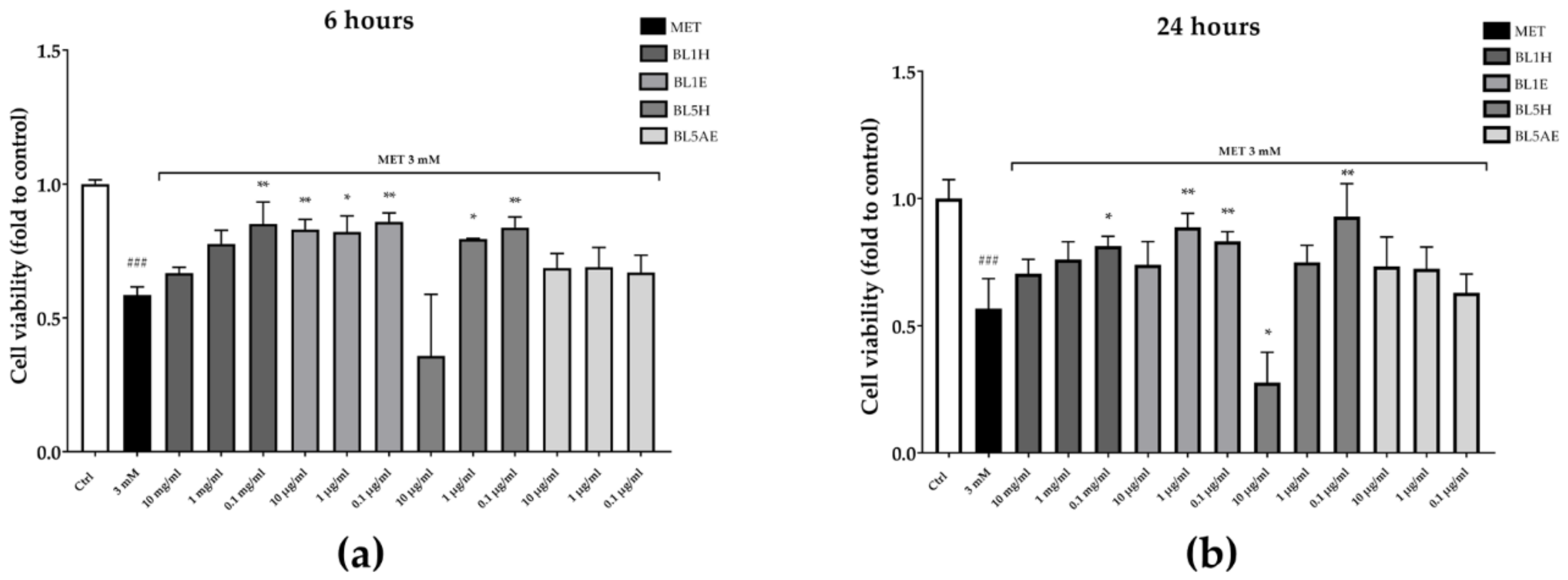
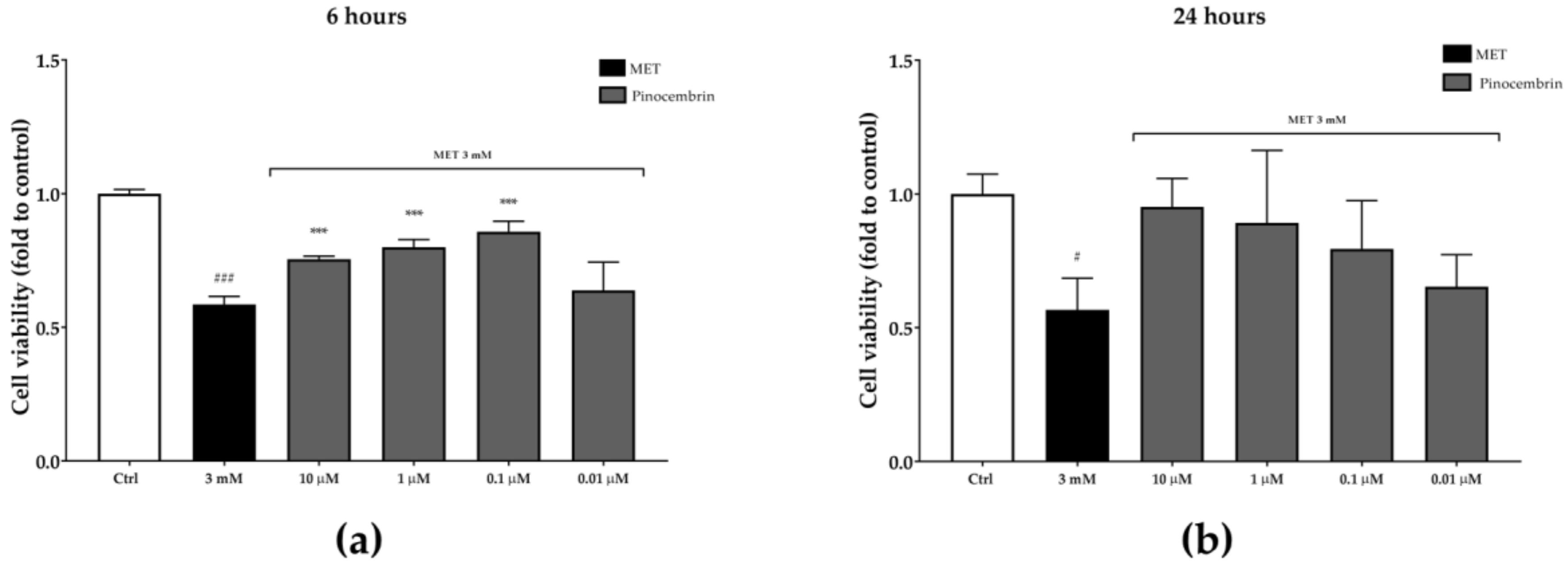
| Compounds | Identify Similarity | BL1E | BL1NH | BL1AE | BL5E | BL5NH | BL5AE | BL2E | BL3E | BL4E |
| 1-Methylisoquinoline | RI | 0.32 | - | 0.18 | - | - | - | - | - | - |
| 1-Hexadecene | RI | - | - | - | - | - | - | 0.37 | - | - |
| 1-Methoxy-4-propylbenzene | RI | 0.75 | 2.33 | - | - | 0.63 | - | - | - | - |
| 1-(4-Aminophenyl-etyhanone | RI | - | - | - | - | - | - | - | 1.62 | - |
| 2(1H)-quinolinone | RI | - | - | - | - | - | - | - | 1.20 | - |
| Ethyl benzoic acid | RI | 0.50 | - | - | - | - | - | - | - | - |
| Benzoic acid | RI/MS | 6.61 | - | 0.79 | 11.98 | - | - | - | 5.36 | 7.94 |
| 4-Methoxy benzoic acid | RI | 1.51 | 0.98 | - | - | 0.45 | 0.64 | - | - | - |
| 4-Methyl-1,1’-biphenyl | RI | 0.31 | - | - | 0.38 | - | - | - | - | 3.34 |
| 2,4-Bis(1,1-dimethylethyl)-phenol | RI | 0.82 | - | - | - | - | - | - | - | 1.72 |
| 2,5-Dipropyl-thyophene | RI | - | - | - | - | - | - | - | 1.98 | |
| 4-Hydroxy-3,5,6-trimethyl-4-(3-oxo-1-butenyl)-2-cyclohexen-1-one | RI | 0.50 | 2.32 | - | - | - | - | - | - | |
| Benzyl benzoate | RI | 0.90 | - | - | 11.37 | - | - | - | - | - |
| 5-Tertbuthyl-m-cymen | RI | - | - | - | - | - | - | - | - | 29.1 |
| 6-Methoxy-6H-dibenzo[b,d]pyran | RI | 1.25 | 1.90 | 0.18 | 0.36 | 0.08 | 1.80 | - | - | - |
| 6,7,8,9-Tetrahydro-2H-benzofuro(3,2-g)(1)benzopyrane-2-one | RI | - | - | - | - | - | - | - | 1.80 | - |
| Benzoic acid phenyl ester | RI | 0.24 | - | - | - | - | - | - | - | 2.07 |
| 1-(4-Hydroxy-3,5-dimethoxyphenyl)-ethanone | RI | 0.40 | - | 0.58 | - | - | 4.65 | - | - | - |
| Eicosane | RI | - | - | - | - | - | - | 0.25 | - | - |
| Myristic acid | RI | - | - | - | - | - | - | 2.80 | - | - |
| Nonadecane | RI | - | - | - | - | - | - | 1.30 | - | - |
| Palmitic acid | RI/MS | - | 0.50 | - | - | - | 0.13 | - | - | - |
| Oleic acid | RI/MS | - | 0.33 | - | - | 0.04 | 1.11 | 10.09 | - | - |
| Octadecane | RI | - | - | 9.27 | - | - | - | - | - | - |
| 1,1’-Methylenbis-benzene | RI | - | 1.61 | - | - | 0.59 | - | - | - | - |
| 9-Eicosene | RI | - | 0.78 | - | - | - | - | - | - | - |
| 4H-pyran-4one, 2,3-dihydro-3,5-dihydroxy-6methyl | RI | - | - | 9.75 | - | - | 0.59 | - | - | - |
| 5-Hydroxymethyl-2-furancarboxaldehyde* | RI | - | - | 42.3 | - | - | - | - | - | - |
| 5,5’-Oxy-dimethylene-bis(2-furaldehyde) | RI | - | - | 6.32 | - | - | - | - | - | - |
| Pentacosane | RI | - | - | 8.10 | - | - | - | - | - | - |
| Pinocembrin | RI/MS | 0.63 | 9.09 | 1.08 | 1.13 | - | 0.98 | - | - | - |
| Pinocembrin-7-methyleter | RI | 0.32 | - | 2.99 | 0.74 | - | 1.95 | - | - | - |
| Squalene | RI | - | - | 3.64 | 1.54 | - | - | - | - | - |
| Tritetracontane | RI | - | - | - | - | - | - | 0.57 | - | - |
| (Z)-9,17-octadecadienal | RI | - | - | - | - | - | - | 0.39 | - | - |
| (Z)-7-hexadecene | RI | - | - | - | - | - | - | 0.47 | - | - |
| Compounds | Multiplicity | δ H (ppm) | BL1Ha | BL1E | BL5H | BL5AE |
|---|---|---|---|---|---|---|
| Proline (β, β’ CH2) | m | 2.23 | + | - | - | - |
| Proline (γCH2) | m | 2.05 | - | - | + | - |
| Succinic acid (α-β CH2) | m | 2.68 | + | - | - | - |
| Citric acid (CH2) | d | 2.87 | + | - | - | - |
| Malic acid (βCH2) | dd | 3.06 | + | - | - | - |
| β-Glucose (H4) | dd | 3.40 | + | - | + | - |
| Tyrosine (αCH) | m | 3.43 | - | + | - | - |
| α-Glucose (H4) | dd | 3.45 | - | - | + | - |
| Pinocembrin-7-methylether (OCH3) | s | 3.90 | - | + | - | + |
| β-Glucose (H1) | d | 4.45 | + | - | + | - |
| Fructose | m | 4.00 | + | - | + | - |
| β-Rhamonose (H1) | d | 4.86 | - | - | + | - |
| α-Glucose (H1) | d | 5.02 | + | - | + | - |
| Turanose (H1) | m | 5.10 | + | - | - | - |
| Maltose (H1) | m | 5.30 | + | - | - | - |
| Maltose (H1) | d | 5.36 | - | - | + | - |
| Sucrose (H1) | d | 5.42 | - | - | + | - |
| Chrysin (C6) | m | 6.11 | + | - | - | - |
| Tyrosine (H3, H5) | d | 6.84 | - | - | + | + |
| Phenyl acetic acid | m | 7.10 | - | - | - | + |
| Tyrosine (H2, H6) | s | 7.20 | - | - | + | + |
| Phenylalanine (Ph) | m | 7.4–7.7 | - | + | - | + |
| Pinocembrin (Ph) | m | 7.40 | - | + | - | + |
| Hydroxymethylfurfural (H3) | d | 7.54 | - | - | - | + |
| Pinocembrin (5OH) | s | 12.00 | - | - | - | + |
| γ-LACT-3-PKA (C8) | s | 8.45 | - | - | + | - |
| Treatment | 6 h | 24 h |
|---|---|---|
| Ctrl | 20.19 ± 2.53 | 52.36 ± 2.31 |
| TGF-β 4 ng/mL | 17.97 ± 0.44 | 59.84 ± 2.61 * |
© 2019 by the authors. Licensee MDPI, Basel, Switzerland. This article is an open access article distributed under the terms and conditions of the Creative Commons Attribution (CC BY) license (http://creativecommons.org/licenses/by/4.0/).
Share and Cite
Governa, P.; Carullo, G.; Biagi, M.; Rago, V.; Aiello, F. Evaluation of the In Vitro Wound-Healing Activity of Calabrian Honeys. Antioxidants 2019, 8, 36. https://doi.org/10.3390/antiox8020036
Governa P, Carullo G, Biagi M, Rago V, Aiello F. Evaluation of the In Vitro Wound-Healing Activity of Calabrian Honeys. Antioxidants. 2019; 8(2):36. https://doi.org/10.3390/antiox8020036
Chicago/Turabian StyleGoverna, Paolo, Gabriele Carullo, Marco Biagi, Vittoria Rago, and Francesca Aiello. 2019. "Evaluation of the In Vitro Wound-Healing Activity of Calabrian Honeys" Antioxidants 8, no. 2: 36. https://doi.org/10.3390/antiox8020036
APA StyleGoverna, P., Carullo, G., Biagi, M., Rago, V., & Aiello, F. (2019). Evaluation of the In Vitro Wound-Healing Activity of Calabrian Honeys. Antioxidants, 8(2), 36. https://doi.org/10.3390/antiox8020036








